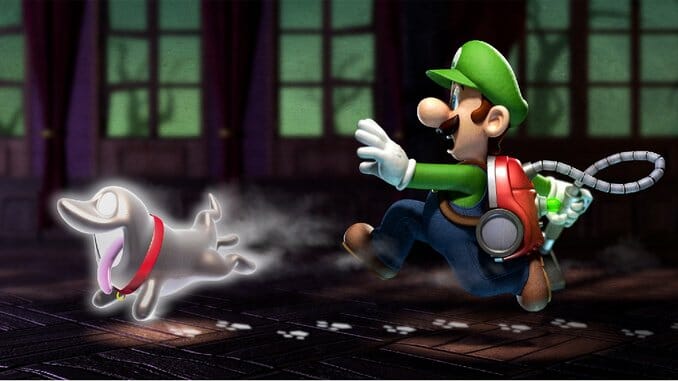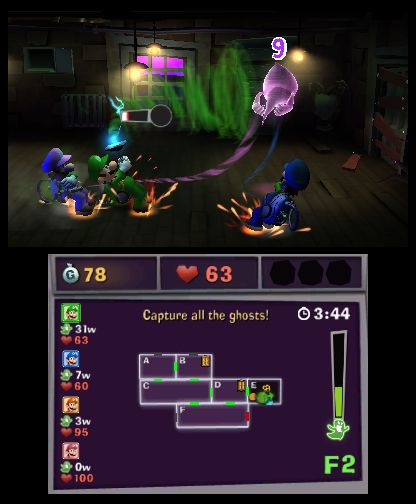
The prescribed motion for effective vacuuming is usually a repeated back-and-forth treatment over whatever surface needs to be cleaned. The vacuum itself, having only this single, mundane use, is a cumbersome instrument. Function and form combined, vacuuming is hardly an engaging activity for mind or body. But then, most of us don’t live in large Victorian houses or abandoned clock factories, and don’t have to worry about choking our bulky appliances with anything more dreadful than pocket change or action figures.
You know who does have to worry about that? This guy named Luigi. Mario’s shier, lankier, less prolific brother grabs the spotlight for the first time since the first Luigi’s Mansion launched alongside the Nintendo GameCube in 2001. That game made a strong case for his worth as a capable, if cowardly, lead character. The titular estate’s clever, puzzle-filled antiquity set up each room as an elaborate scene worth peering, poking and vacuuming through. Its spectral tenants, of all shapes and personalities, made for entertaining pests. Playing Luigi’s Mansion was seeing a new console test its footing, but also host one of its most iconic creations. The game was an original and intuitive experience at best, and an unconventional assemblage of ideas at worst. To follow it up has taken time, a change of platform, and more than a little reworking of the concepts that made the game an endearing curiosity.
More content with a quiet night in an armchair than with playing the hero, Luigi reluctantly resumes the practice of ghost capturing. It’s hardly a fulfilling line of work: He’s taunted by every spook, chided by the absent-minded Professor E. Gadd, and thrown into the thick of it with little preparation. But the game gives his animated agitation texture. Every stumble, whimper, and small burst of courage reaffirms Luigi as a character with appreciable qualities beyond his regulation overalls and trembling voice, one worth chuckling at and cheering for in equal measure. Dark Moon’s settings evoke an amusingly ominous, portrait-painting-peephole feeling, and despite Luigi’s distress at tiptoeing around cobwebs and tall suits of armor, the game’s intimate spaces trade more on the trickery and mischief of the afterlife than its menace.
The game’s five mansions (a term used ever more loosely with each successive area) are less a collection of monster closets than they are monster’s attics—they’re packed from the rafters down to the floorboards with searchable oddities and hidden spaces, primed with dormant tricks and rewards. The game’s visual design and use of 3D makes the player’s viewpoint comparable to peering into a dollhouse. It’s an aesthetic that suits the kind of playful, single-factor points of interaction each room contains. Once you learn the telltale signs for what Luigi and his vacuum can affect, it becomes second nature to canvas each distinctive area for stray items you can latch onto or invisible objects that sparkle under your special flashlight.

These spaces are effective because they’re clever, but not in a way that would ever make the player feel less so upon eventually finding their solution. The reward for uncovering even the most inconsequential device is both that you found it and that you solved it. Between these two states there’s little separation, and no period of struggle or frustration. Like a Rube Goldberg machine, every interaction you make in a mansion also has an equally important and gratifying visual effect, an indicator of what you accomplished. Spin up the ceiling fan, and watch a false wall retreat to reveal a stash of treasure.
Poking at the playful machinery of each extensive area—ropes and levers, pulleys and trapdoors—is, for most of Dark Moon, a more prominent process than actually netting ghosts. This is due in part to the bump in scope and length the game gives each setting. Unlike with the first game’s single mansion, Dark Moon splits Luigi’s visit to each location into self-contained missions with distinct beginning and end points. The further into the game you go, the higher, lower and deeper missions take you into a mansion’s twisty structure. Increasingly, these surroundings are actually complex landscapes with a structural facade, plain architecture hiding passageways, caverns and varying degrees of verticality that take time to move through, even in chunks. Eventually, the established motion of exploration is not a simple back-and-forth, but a side-to-side, down-to-up, and in-and-out of spaces you didn’t even notice at first.
It’s this wealth of size and length that best demonstrates Dark Moon’s ill structured save system. A mission can take anywhere from 10 minutes to half an hour. If you die (without having acquired a special item in that stage), you start from scratch. If you want to take a break, your only option is to shut the 3DS. The benefits of Dark Moon’s expanded design are blunted by being hamstrung if you don’t have the time or desire to see a mission through (although don’t expect the latter to happen often.)
Though attention is rightfully paid more to the quirks of the mansions than to their inhabitants, clearing out the ghosts remains a necessity. However, it’s not as arduous and climactic an experience this time around. Their role is more to obstruct your progress rather than to assault you directly. Eventually, they’ll get in your face, and force you to read and adapt to their respective vulnerabilities. These enemies have charm and identity, with color categories determining their temperament—gleeful green pranksters; churlish red bruisers; blues that play hide-and-seek. A smart translation of the first game’s twin-stick combat controls to the 3DS Circle pad and face buttons makes the process of stunning and reeling in ghosts feel like something more than busywork. Intermittently busting ghosts in cordoned off rooms and hallways has less dimension than exploring a mansion’s myriad nooks and crannies, but it’s still simple and satisfying to do, particularly with other players in the game’s local and online competitive co-op mode.
The best parts of Dark Moon feel like an interactive silent film—the bumbling yet capable Luigi exploring on his own, fearing and falling for a mansion’s subtle tricks—and are complemented by superb animation and audio work. When the game interrupts that structure with banal instructional calls from E. Gadd or ends it abruptly once you’ve met a mission’s parameters, it creates a pace of play that’s convenient (save problems notwithstanding) at the expense of some wanted control. Even so, the sheer amount of detail and creativity in Dark Moon’s iterative design makes experiencing another Luigi caper more than worth the small inconveniences.
Luigi’s Mansion: Dark Moon was developed by Next Level Games and published by Nintendo. It is available for the 3DS.
Nate Andrews is a freelance writer and critic based in East Lansing whose work has also appeared in Unwinnable, Medium Difficulty and Nintendo World Report. He writes at nandrews.tumblr.com and tweets @_nandrews.